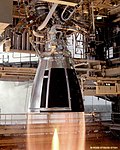NK-15
Appearance
| Country of origin | Soviet Union |
|---|---|
| Date | 1960s |
| Designer | Kuznetsov Design Bureau |
| Application | 1st/2nd-stage engine |
| Predecessor | NK-9[1] |
| Successor | NK-33 |
| Liquid-fuel engine | |
| Propellant | LOX / RG-1 |
| Mixture ratio | 2.52:1 (oxidizer:fuel) |
| Cycle | Staged combustion |
| Pumps | Turbopump |
| Performance | |
| Thrust, vacuum | 1,544 kN (347,000 lbf) |
| Thrust, sea-level | 1,526 kN (343,000 lbf) |
| Throttle range | 50–105% |
| Thrust-to-weight ratio | 126.22:1 |
| Chamber pressure | 7.85 MPa (1,139 psi) |
| Specific impulse, vacuum | 318 s (3.12 km/s) |
| Specific impulse, sea-level | 297 s (2.91 km/s) |
| Dimensions | |
| Length | 2.7 m (8 ft 10 in) |
| Diameter | 1.5 m (4 ft 11 in) |
| Dry mass | 1,247 kg (2,749 lb) |
| References | |
| References | [2] |
The NK-15 (GRAU index: 11D51) was a rocket engine designed and built in the late 1960s by the Kuznetsov Design Bureau. The NK designation was derived from the initials of chief designer Nikolay Kuznetsov. The NK-15 was among the most powerful LOX/kerosene rocket engines when it was built, with a high specific impulse and low structural mass. It was intended for the ill-fated Soviet N-1 Moon rocket.
History
[edit]The engine equipped the N1 rocket - the first two launch attempts failed due to this engine.[3] Its successor, the NK-33 was to be used on the N1F, a new version of the N1, but the program was cancelled.
Versions
[edit]- NK-15V (GRAU index: 11D52): modified NK-15 optimized for vacuum operation, used on the second stage of the N1.
See also
[edit]References
[edit]- ^ Kiseleva, Mariia (2021-11-24). "Soviet Rocket Engines". Everyday Astronaut. Retrieved 2024-12-18.
- ^ "NK-15". Encyclopedia Astronautica. Retrieved 2024-12-19.
- ^ Chertok, Boris E. (2011). Rockets and people (PDF). Washington, DC: NASA. p. 208,230. ISBN 978-0-16-089559-3. Retrieved 9 August 2021.

